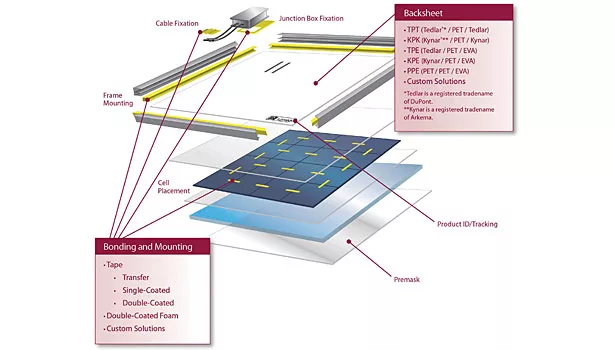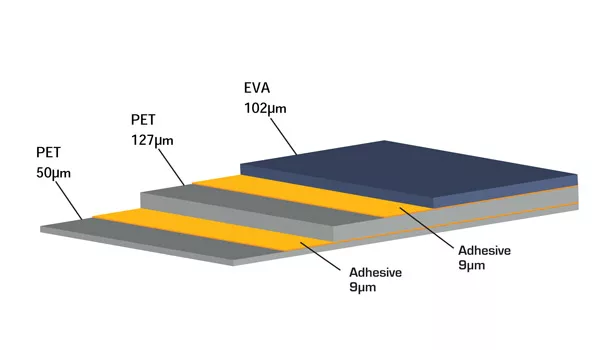Backsheets: From Conception to Finished Products



Mention solar panels or solar arrays to the average citizen, and thoughts of long, sunny days and moderate to high temperatures might enter their mind. Perhaps some might even envision a semi-tropical locale with gentle breezes wafting by. Most (if not all) solar panel installers wish that type of location was the reality. In truth, however, while sunlight is the prime factor in placing solar panels in order to maximize their usefulness as energy receptors, solar installation sites are not always warm and comfortable.
In many instances, solar installations are positioned in harsh climates and difficult locations. Because of this, all the non-solar-cell components have to be tested and found able to withstand conditions ranging from deep frosts to extreme heat, as well as high winds, ice, snow, sleet, rain, and any other type of potentially damaging moisture—even debris impingement. The various elements that make up the finished module must prove to be consistently able to perform, whether in an industrial array or for consumer use.
SOLAR MODULE COMPONENTS
Films and adhesives can play a critical role in the general construction and performance of solar modules (see Figure 1). A premask, or protective film, is applied to an anti-reflective glass panel. This premask protects against scuffing and scratching during assembly, transport, and installation. Since silicon, the primary component of solar cells, is very reflective, it can dissipate photons before they can be harnessed and converted into useable energy. Therefore, the panel of anti-reflective coated glass is important.
Solar cells are arranged in a pattern, usually forming a square or rectangle. They are held in place by a double-coated pressure-sensitive film. Once the cells are arranged and secured, they are placed in a frame, and a backsheet is applied to the underside. A junction box is then affixed to the solar panel to allow for connectivity with other panels.
The backsheet consists of multiple layers of barrier films and adhesives (see Figure 2). The construction is instrumental in protecting the solar panel from moisture, UV exposure and other environmental threats. Backsheets also improve solar module efficiency by helping to reduce partial discharge. Most constructions engineered for back laminates consist of combinations of films chosen for the different properties they exhibit. Examples of standard films include: polyester (PET) or ethylene vinyl acetate (EVA) and Tedlar® and Kynar®. Combinations can range from Tedlar/PET/Tedlar (TPT), Kynar/PET/Kynar (KPK) to PET/PET/EVA (PPE) or EVA/PET/EVA (EPE). Combinations can also include TPE (Tedlar/PET/EVA) and KPE (Kynar/PET/EVA), depending on what is needed for maximum efficiency and optimum performance.
BACKSHEET EVOLUTION
Film constructions consisting of three layers are primarily used for photovoltaic backsheets and have been used in one form or another since the early 1960s, when Dupont’s Tedlar (polyvinyl fluoride) was the film of choice. Tedlar was first developed as a residential siding material, where it was shown to be able to withstand all of the elemental challenges of the outdoors and quickly became the “go-to” film for backsheet applications (along with a 25-year warranty). The evolution of these backsheet constructions started with a film sandwich, so to speak, consisting of two layers of the Tedlar material with a layer of PET in between. While it was thought that two layers were better than one, it also proved to be more difficult to engineer and more expensive to produce.
Eventually, fluoropolymer and non-fluoropolymer materials were tested and found to be highly effective in both single and double fluoropolymer constructions. Arkema offers a fluoropolymer called Kynar that offers equal performance to the increasingly-hard-to-obtain Tedlar. While Kynar has been providing surface protection with impressive longevity for over 40 years, it rapidly proved a popular alternative in both single- and double-layer constructions.
Higher demand for backsheets means an increase in the demand for higher performing, less costly materials. Some of the available films include:
- Double fluoropolymer—Generally constructed of two layers of either Tedlar or two layers of Kynar, it not only tops the performance charts, but the price list as well. As mentioned, both Tedlar and Kynar are similar in performance, while Kynar is more readily available.
- Single fluoropolymer—The construction choice of most major applications, it consists generally of one layer of either Tedlar or Kynar and still provides excellent durability and performance.
- Non-fluoropolymer—Cost-effective and durable, it is able to support varying warranties and is the affordable option to fluoropolymer. It is quickly gaining in popularity as manufacturers seek more economical alternatives.
Looking for a reprint of this article?
From high-res PDFs to custom plaques, order your copy today!




